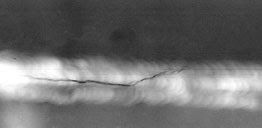X-Ray Radiography
X-ray radiography is a nondestructive testing method that uses electromagnetic energy in the form of x-rays. The difference between x-ray and gamma-ray radiographs is that although x-rays and gamma-rays are fundamentally the same type of electromagnetic radiation, the quality of radiation produced is based on their origin and their differing energy spectra. X-ray sources generate a continuous range of energies up to a maximum which is dependent on the operating kilo voltage (kV), while gamma-ray sources produce fixed line spectra at specific photon energies and abundances. The weld being radiographed attenuates the beam of radiation by removing the lower photon energy components in proportion to the material type and thickness. An x-ray generator (also known as an x-ray tube) transforms electrical energy to produce x-rays, and is controlled to stop x-ray emission when the equipment electrical power is turned off.
The radiographic image is a two-dimensional negative of the object on a film that is sensitive to radiation exposure. Radiography has the ability to detect surface and subsurface defects and/or discontinuities.
X-ray radiography is typically performed on most metallic and non-metallic materials including, electrical components, composites, welds, castings, forgings, fittings, valves and components, pipe, machined parts and pressure vessels.
Due to the radiographic image being two-dimensional, the depth of a defect and/or discontinuity requires additional NDT which is typically performed using ultrasonic inspection. Access to both sides of the object is required, and the processed film image is viewed and interpreted under a variable high intensity white light.
The practical thickness limit for carbon steel for x-ray generators is up to an average of 1.5” with our portable equipment.
Safety is a critical consideration when using x-ray generators. Clearance of large areas adjacent to the subject material is required to ensure the safety of NDT personnel and the general public.





